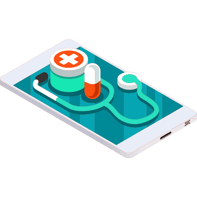2020 Roundup - Ten Healthcare Trends That We Believe are Here to Stay

While we are still reeling from the onslaught of the pandemic, it is useful to reflect on and investigate some of the occurrences that will pave the way for healthcare in the coming years. Even if it wanes with the current delivery of multiple vaccination candidates, COVID-19 has made an indelible mark on our healthcare system.
Here are ten of the most important trends that we expect to emerge or gain traction in 2021, as the veil of COVID-19 is pulled back.
- Reimbursements continued to be pinched. As was expected in the United States, pandemic or not, Centers for Medicare and Medicaid Services (CMS) will be putting the screws to reimbursement of certain procedures in order to maintain it’s budget-neutral targets. Expect medical imaging to be one of those areas where there will be a material reduction in reimbursement rates.

- Virtual care is here to stay. While the pandemic introduced or accelerated the percent of adoption of remote healthcare to double digits, the percentage of virtual visits has returned closer to pre-pandemic levels – but not zero. Virtual care will take its rightful place as one of the methods of the delivery of healthcare.
- Rural healthcare in the US has taken a beating. While most hospitals have suffered from the reduction in procedures, rural institutions who were already on the financial razor’s edge, are failing fast. It is incumbent upon the government to fortify this critical resource.
- Consolidation of providers will speed up, slow down, and then …. Perhaps counter intuitively, private physician groups, at least the ones that survived, seem to be wielding more power as they continue to interact with the health systems they serve. Hospitals may consider snapping up the weaker physician practices in need. Strong physician groups will remain independent and will wield more strength in their continuing arms-length relationships with their health institutional counterparts.
- Artificial intelligence (AI) is increasingly a smarter choice. But the definition of AI continues to be confusing. Using libraries of existing data to infer suggested responses is getting more reliable as the data continues to amount. But the moniker is confusing and misleading and will likely never become a viable substitution for a medical degree.
- Speaking of medical degrees, in the United States, there has been a surge of applications for medical school. You might think with the duress doctors have and continue to endure that the profession might be less appealing. But leave it to the patriotic youth who are rallying to the call for growing the ranks of the medically trained.
- Technology continues its appeal. Interestingly, the more invisible the better. Physicians’ core competence has never really been technology. The result is that the most appealing technology is the one with the least disruption to the practice. The less invasive and the fewer required clicks, the better.
- Value-based care will predominate. Patients will choose where to consume their healthcare. Payers will steer clients to lower-cost resources. High-value surgical alternatives to hospital procedures will increase in popularity.
- Alternatives will emerge to the emergency department. Hospitals will establish buffers to handle not-so-critical emergency department visits in something that is akin to an urgent care center environment. This will leave the emergency department for real emergencies.
- Retiring in place will continue to grow in appeal. Aging at home is a growing trend. Naturally occurring retirement communities (NORCs) are beginning to emerge. These NORCs are unplanned tightly connected communities whose density makes it advantageous to deliver community-based care.
And of course, we will still see COVID-19 rearing its ugly head for at least the first half of the year. The newly approved parade of vaccines will certainly help. But with the backlog of procedures and the avoidance of preventive care forming a tsunami on the horizon, the health care system won’t return to anything close to normal, until near the end of the year.


